Accelerated Construction Using Precast Concrete Pavement Systems
slide 1: Accelerated Construction Using Precast Concrete Pavement Systems
The Illinois Tollway
FHWA Webinar
May 30, 2013
Download the Printable Version [PDF,
3 MB]
You may need the Adobe® Reader® to view this PDF.
slide notes:
None.
slide 2: The Illinois Tollway

slide notes:
For those of you not familiar with the Tollway system:
- The Tollway system currently includes 4 interstates with 286 miles of roadway across 12 counties in Northern Illinois – Tri-State (I-94/294/80), Reagan Memorial (I-88), Jane Addams Memorial (I-90) and the Veterans Memorial (I-355)
- Built as a bypass in 1958, the Tollway system first served 66,000 daily drivers. Today 1.4 million daily drivers across 12 counties in Northern Illinois.
- With more than 86 percent of the tolls paid electronically, the Illinois Tollway operates the largest electronic tolling system in the nation.
- User-fee system that receives no state or federal tax dollars to fund maintenance or operations.
- We are currently in the middle of a massive 22 year 18 billion dollar capital development program that will reconstruct and widen most all of the expressways on our system. Many miles of pavement remain to be maintained.
slide 3: More Sustainable Concrete Pavement Rehabilitation / New Construction
Get In
&
Get Out
&
Stay Out
slide notes:
Because the Tollway is totally a user fee system with no dependence on tax dollars, the traffic is our only source of revenue. Therefore, accelerated construction is critical to minimize lost revenue due to the traffic being diverted to other routes during construction operations. Serving 1.4 million daily drivers, mostly commuters, on our system is not easy to maintain when rehabilitation or new construction is needed. With this presentation I focus on how we minimize traffic impact and reduce safety risks during the rehabilitation or reconstruction of our concrete pavements with the use of precast pavement systems.
slide 4: Why Precast Patching Has Value, Especially in the Middle Lanes
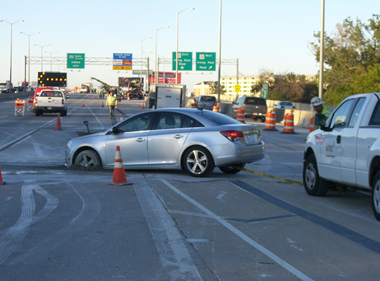
slide notes:
Our systemwide traffic levels are high with wild driving commuters, making it all the more dangerous for us to repair and construct roadways during peak traffic hours. Splitting traffic around middle lane construction or repair operations during the peak hours of traffic can be devastating to our system relative to traffic back ups induced or as a result of reduced safety to both the motoring public and to our construction crews.
Too often when middle lanes of our expressways were being shut down for repair work and the traffic was diverted around the construction operation, situations such as what is shown on this slide would be a common occurence.
As a result, overnight precast pavement patching or new construction applications were seen to be needed on the Tollway system within the last 10 years and much effort has been taken to get precast systems developed for many applications on our system besides just middle lane patching.
slide 5: First Precast Application in 2002 – Uretek Method
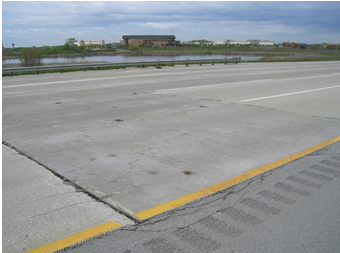
slide notes:
In 2002 Uretek, a major national supplier of polyurethane foam material used to stabilize subbases under pavements or to jack settled slabs, proposed to the Tollway to try their product under a precast slab. It was a free demonstration at a location of a shattered slab on I-355 and was the Tollway's first learning experience of how an emergency repair could be performed using precast pavements. The slab is still in place under a recently placed overlay with no evidence of distress yet to be shown.
slide 6: Proprietary Fort Miller System Introduced in 2007
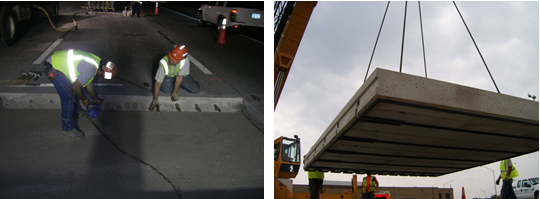
slide notes:
The first and primary precast system that was being used over the last ten years in the states was the Fort Miller system. It is a proprietary system that operates out of the State of New York. The Tollway witnessed operations of placement using the system all over the country and the Fort Miller system was the primary system we used to develop initial standards for precast pavements. A demonstration pad using the Fort Miller system was analyzed with falling weight deflectometers to verify that an efficient load transfer across the joints was being provided with such a system.
slide 7: Competition Needed in More Ways than One
- More than 1 precast concrete pavement system was proven to be needed in 2008
- To some extent, precast concrete has to compete with high performance cast-in-place concrete
slide notes:
In 2008 the Fort Miller system was formally approved by the Tollway for application to both new construction and rehabilitation contracts around the system. Unfortunately, it was value engineered out of most contracts that year. Being a proprietary system, too much of the cost to produce the product was going to the Fort Miller organization and not to the local contractors. Therefore, the contractors took every political route possible to get the concept killed. This taught the Tollway that an alternative non-proprietary system was needed to make it a practical application economically in the Chicago environment.
slide 8: Tollway's Generic System Developed in 2009
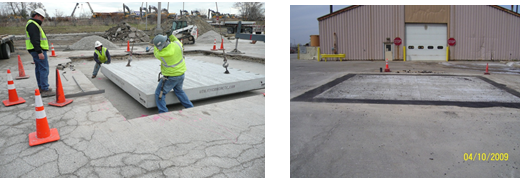
slide notes:
This slide shows the initial placement of the Tollway's generic system in one of our maintenance yards in 2009. Just like the Fort Miller system, it was tested for load transfer efficiency across the joints to allow for formal approval of the procedure.
slide 9: Tollway System Provides Options for Dowel Bar Retrofitting
| Standard wide mouth retrofitting method 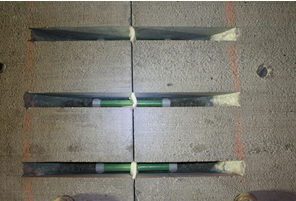 |
New pre-drill / narrow mouth procedure |
slide notes:
The original Tollway system was designed using the standard dowel bar retrofitting procedure to connect all slabs such as shown with the photo on the left side of this slide. The wide mouth dowel slots are saw cut through the top of any slabs, chipped out and then the dowels set on chairs across the joints before being backfilled with high early strength mortar. With the Fort Miller system, the patented process requires dowels to be predrilled and epoxied into adjacent slabs and then the precast slab with preformed slots on the underside is placed within the opening and the dowel slots grouted through port holes on the top of each slab.
With the wide mouth retrofitting, it was learned that the open slots were somewhat of a burden to the contractors. Because of safety, the wide mouth slots had to be retrofitted and filled immediately after placement with high early strength grout, or filled with a temporary fill material before being opened to traffic the next morning.
With the help of the SHRP 2 R05 research team, we developed a design for preformed narrow mouth slots in the precast slabs that would not require the slots to be retrofitted immediately or be temporarily filled. This made the installation process much more efficient. The photo on the right side of this slide shows the Tollway's generic narrow mouth method.
slide 10: Tollway's Generic System Successfully Placed Last 3 Years Using Both Methods
With wide mouth retrofits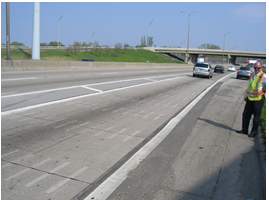 |
With narrow mouth retrofits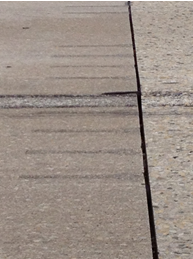 |
slide notes:
The photo on the left of your screen shows our first application of the Tollway's generic system in 2010 using the original wide mouth slot option. Continuous slabs were placed on the ramp of an interstate to interstate interchange as an overnight repair method for around 100 ft. of shattered pavement slabs.
The photo on the right of the slide shows a more recent 2012 placement of isolated precast slab repairs or replacements that used the narrow mouth slot option. Nearly 700 precast slabs were placed during overnight hours on this project. No impact to the morning or afternoon commuter resulted from either of these projects.
slide 11: Isolated Joint / Slab Repair Applications
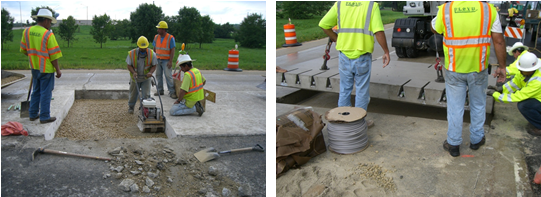
slide notes:
Now let me summarize to you how we commonly apply precast pavements on our system and how other agencies commonly do it as well.
Isolated repairs is our most common need for precast applications. On high volume ramps or in the middle lanes of expressways where long life full depth repairs are needed overnight is where we most commonly apply precast pavements using single isolated slabs to repair mid slab cracks or deteriorated joints in exposed concrete pavements. Cast-in-place patching can be performed using high performance accelerated cast in place concrete in the outer lanes only on weekends when lower volume traffic levels exist and where traffic can easily be shifted to the shoulders. Our objective is to eliminate split traffic on our expressways as much as possible for safety reasons.
slide 12: New Construction Applications
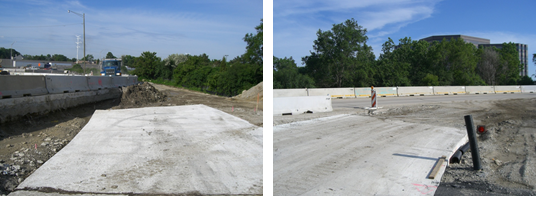
slide notes:
This slide shows both sides of an existing Tollway ramp where the ramp was being reconstructed on a new path in 2008. Both photos show the new ramp sections built up to either side of the existing ramp using a current standard cast-in-place method. When the cast-in-place concrete ramp pavement was ready to be opened to traffic, the ramp was shut down for a weekend, the old ramp pavement was excavated and the gap was filled in with precast pavements. There was a toll plaza at the bottom of this high traffic volume ramp and we could not sacrifice lost toll revenue by shutting down the ramp for weeks to allow for reconstruction using the standard construction methods.
slide 13: Large Area Consecutive Slab Repair Applications
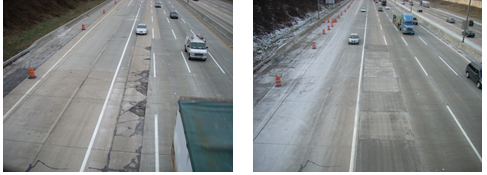
slide notes:
The photo on the left side of this slide shows a long stretch of shattered slabs in the middle of our Tri-State or I-294 corridor that resulted from design oversights when the roadway was reconstructed under two separate contracts. The outer lanes were designed under one contract and inner lanes through another, yet no one accounted for the middle section of roadway, which resulted in the immediate breakup seen. This resulted in the need for an emergency replacement of these lanes during night time hours and precast was the only choice. The photo on the right shows the repaired pavements after precast patching was applied. The photo shows hints of snow off the shoulders, another benefit of precast paving. It can be applied under most all weather conditions.
slide 14: Ramp Reconstruction Applications
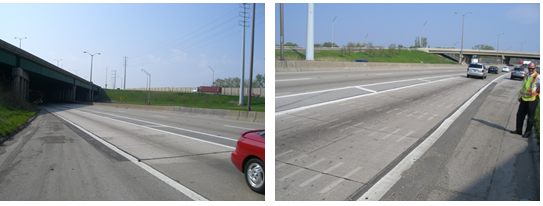
slide notes:
Long sections of our ramps carrying high volume traffic will be partially reconstructed only during the night time hours using precast pavements. This photo was taken in 2010 on the interstate to interstate interchange ramp where the contractor used the Tollway's generic system. There was no shoulder under the bridge as shown on the left photo and precast paving was the only long term repair alternative unless we wanted to shut down the ramp for weeks. This year, a similar application will be applied to another interstate to interstate interchange ramp on a super-elevated curve where the Fort Miller system will be applied.
slide 15: Overnight Intersection Reconstruction Applications
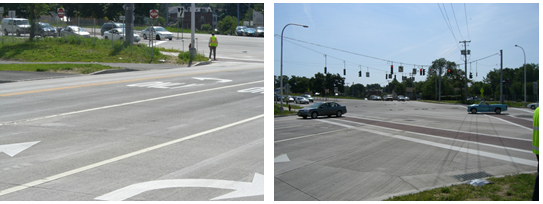
slide notes:
Another application that the Tollway will apply this year will be where a short distance of a ramp is to be reconstructed between existing plazas on the ramp and the local road intersections at the end of the ramp. There commonly is little if any room for traffic to be safely diverted to in zones like this, and to prevent long term shut downs of these ramps or intersections, overnight reconstruction using precast pavements is our only choice.
Replacing or reconstructing high volume urban intersections overnight has been performed numerous times in the northeast using the Fort Miler system.
slide 16: Applications for 2013
- I-55 EB to I-294 NB super elevated ramp – warped continuous
- I-294 to I-80 ramp – warped isolated
- End of ramps at intersections – warped continuous
- I-88 at Highland Ave.
- I-88 at Spring Road
- I-355 patching / overlay – isolated flat
- I-88 patching / diamond grind – isolated flat
slide notes:
To give you an example of how extensive the application of precast paving can be in one year, this slide shows you the projects we will be applying precast reconstruction or repair techniques to this year alone. As the slide indicates both flat and warped or non-planar slabs will be applied to as many as four contracts this year requiring for approximately 1000 or more precast slabs to be produced and placed on the system.
As we implement more of these projects annually and the contractors become familiar with the complicated procedures for slab installation, the prices for precast pavements has been steadily declining with each bid. Original prices 3 to 5 years ago were in the area of $100 or more per square foot of area to repair or reconstruct. Today our prices are in the area of $50 per square foot. In California and in new england states where precast has been used more commonly, the prices have dropped to well below the $50 per square foot price that we are currently seeing.
slide 17: Future Tollway Needs for Precast
- Bridge approach slab replacements overnight
- New integral abutment bridge approach slabs
- Ramp Plaza Replacements
slide notes:
On the Tollway system we foresee the need for even more applications to be coming such as listed on this slide.
Our existing bridge approach slabs built in the last 10 years were not designed properly and settlement and resultant failures are becoming more common every year. The Tollway is in the process of establishing a way that prestressed precast slabs can be used to replace failed approach slabs overnight.
As integral abutment or jointless bridges become more common, in illinois the way to relieve plastic concrete stress in newly constructed approach slabs next to the jointless bridge is to design them as precast slabs.
Toll plaza reconstruction on our ramps is coming down the road, and replacing them with precast pavements with the treadle frames and loop detectors preinstalled in the slabs is the likely route that will be taken.
slide 18: Thank You
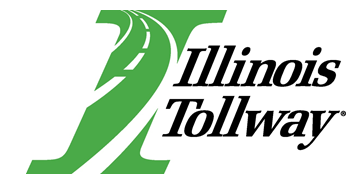
slide notes:
None.